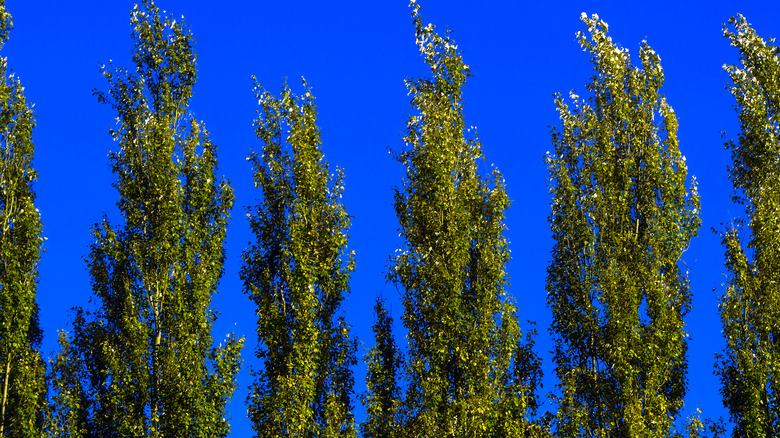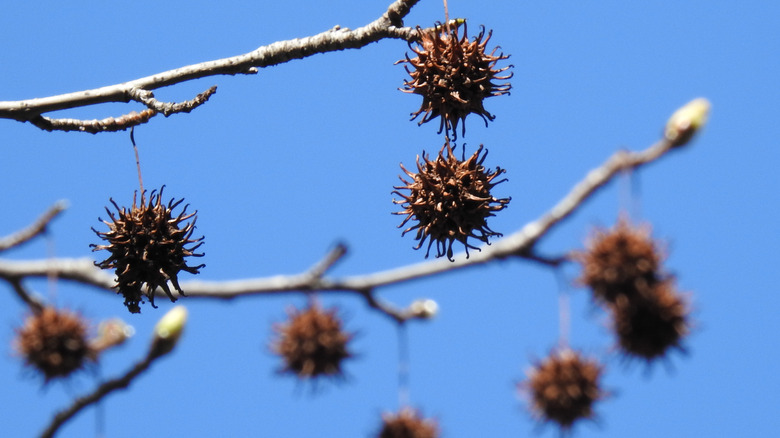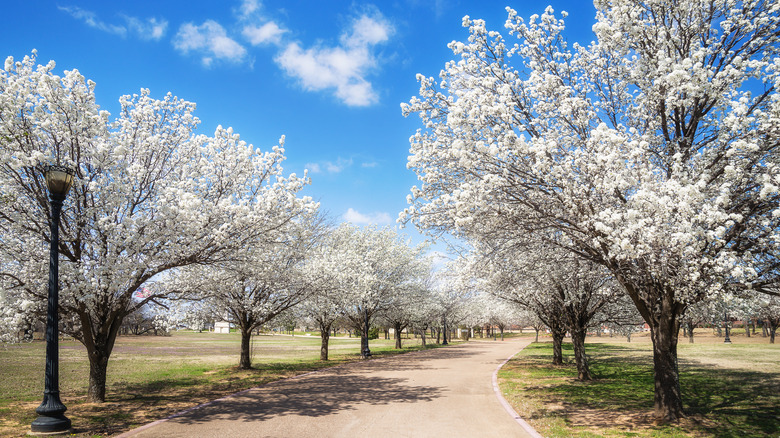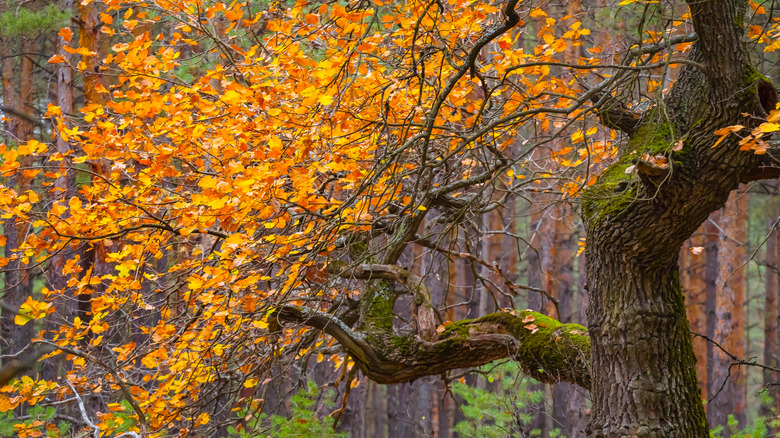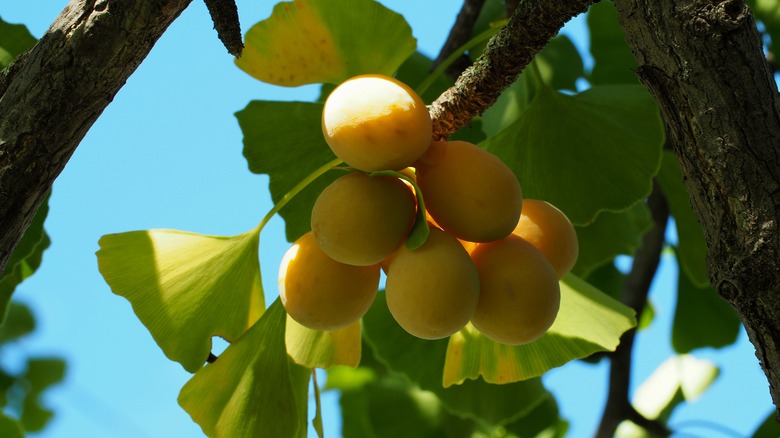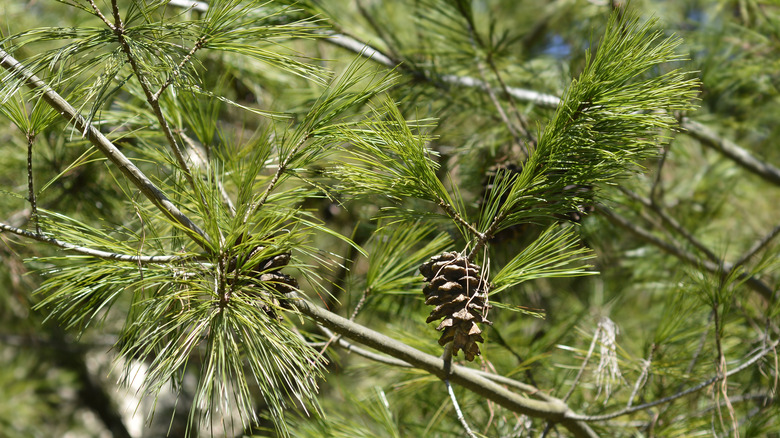5 Trees You Might Want To Think Twice About Before Planting In Your Yard
It's never a bad idea to have some extra greenery surrounding your dwelling. Trees, in particular, bring shade, produce oxygen, provide safe havens for birds and other small animals, and give you some privacy. (They'll also give you something to tie your hammock to).
But you don't want to put just any tree in your yard. What might look like an adorable little sapling could grow into a big problem. Once it takes root and begins to expand its branchy arms and twiggy fingers, you could be looking at too much shade, a lot of leafy maintenance, or ground stability issues due to invasive root systems. You could even end up with disgruntled neighbors who are upset that your deciduous family member is leaving messes in their yard, or perhaps it's even blocked out what little sunlight their property had. The last thing you want to do is plant a tree that ends up turning your yard into a place of chaos. If you plant the wrong tree, The New York Times states that you can even negatively (and unintentionally) upset the ecological balance in your surrounding area.
High-maintenance trees, angry neighbors, and the possibility of negatively impacting flora, fauna, and the soil itself are all legit worries, which is why we've sourced five of the worst offenders when it comes to planting trees in your yard. Front or back, these trees consistently rank high on the "think twice" list. Read on and consider yourself warned.
Sweet gum
There are only six species of sweet gum in this particular genus, but only one lives in the United States. The other five "relatives" all call Asia their home turf, per Arbor Day. The leaves of the sweet gum are somewhat reminiscent of starfish and have a light to medium green hue with a glossy sheen. In the fall and winter, the leaves (like all deciduous trees) begin to turn yellow, red, purple, and orange. Of course, this color change marks the beginning of autumn and the holiday season, but it's also when the sweet gum unleashes its fury in full force.
Sweet gum trees are known for their distinct seed pods (which are actually fruit) that are kind of reminiscent of a flail or morning star, both of which have questionable origins, notes the Public Medievalist. Birds love to hang on them and peck out the seeds that are housed inside these spiky balls of pain. The sweet gum tree is beautiful and grows relatively fast. But when the leaves turn and the pods of pain begin to drop, they do so in buckets. They hurt to step on even with shoes, you can twist your ankle, and getting hit with one will definitely make you question why you thought planting one of these was a good idea. Cleanup and maintenance are more than a chore because it seems like there's a never-ending supply of these bad boys just dropping continuously out of the sky.
Bradford pear
The Bradford Pear wins for its overall visual appeal, but that's also where its story should end. Bradford Pear trees (alias Callery Pear) produce small white flowers every spring, but don't expect them to smell like roses, writes the Missouri Department of Conservation. These funky-smelling flowers will most definitely not set the mood for a romantic picnic. The University of Arkansas Department of Agriculture also notes that this is not the sturdiest of choices when it comes to trees. They're super fragile and are known to split, crack, and break off in high winds. The Bradford Pear pretty much has "home wrecker" written all over it.
On top of that, the lifespan of a Bradford Pear is only around 15 years. You're lucky to get 20 out of it, if the conditions are right, per The University of Georgia College of Agriculture & Environmental Sciences. (If that seems like a lengthy lifespan, the Great Basin Bristlecone Pine is currently the oldest living thing in existence, coming in at over 4,850 years old, via Conservation.org.)
The Bradford Pear must realize that it's not all it's cracked up to be because after perhaps 15 years it begins to self-destruct. Not really something you want to deal with in your lifetime.
Oak tree
Oak trees in general are big. In fact, they're more than big. They're gargantuan, reaching 80 feet in height and 40 feet wide, per Arbor Valley Nursery. Big trees need lots of space to grow, so this is another one you're going to want to steer clear of if you have a small abode. Big trees also mean shade is in abundance. You don't want your house to end up living underneath your new foliage friend.
Oak trees have incredibly deep root structures and are notorious for breaking through pipes, cracking them, or even growing inside your plumbing, writes Express Sewer. They're no stranger to messing up the foundations of houses, either. That's why, should you still wish to proceed with planting an oak on your property, you should make sure that your new oxygen emitter is at least 20 feet away from any structure, per Garden Tabs. Oaks are also deciduous, which means you're going to need to invest in a leaf blower, or get your steps in by raking up the yard during the fall and winter months. If you can imagine a 40-foot school bus, then mentally contort that image into a 40-foot circle ... that's a lot of leaves you'll be raking. And don't forget that oak trees make acorns, which are virtually useless to humans, but animals love them.
Female Ginkgo Biloba
The ginkgo is known as a dioecious tree, meaning that it's either male or female, writes Atlas Obscura. Trees that are able to self-pollinate, or contain both genders of flowers on the same tree, are called monoecious. Why is this important? Because although this tree is considered to be one of the most beautiful and medicinally useful trees in the world, writes Kew Royal Botanical Garden, unfortunately, both male and female plants are going to cause you some serious olfactory issues.
Every year, the male ginkgo plant is responsible for bringing on the pollen party, per The Arnold Arboretum of Harvard University. This tree dude is 100% responsible for your major sneezing, wheezing, and coughing fits (not to mention itchy, watery eyes and runny nose, too). The female ginkgo isn't any less of a tree meanie and also launches a full-throttle assault on your poor sinuses. Instead of releasing a bunch of tiny spores, the female ginkgo produces apricot-looking fruits that contain, like all stone fruits, a pit or seed. Although the leaves are used for medicinal purposes, you'll probably want to stay away from the ginkgo's slippery, fetid fruit. It's Mother Nature's idea of a cruel joke: reign you in to observe a beautiful, symbolically relevant tree only to be repelled by its horribly offensive stench cherry. The name should be changed from ginkgo biloba to stinko bilboba.
White pine
When you go out camping or hiking in high elevations forests, white pine, or pine trees in general, are responsible for giving the air that crisp, clean smell. Right off the bat, this is an evergreen of massive proportions, because it can grow upward of 80 feet tall and 40 feet wide, per North Carolina State Plant Toolbox. So if your yard is a bit on the small side, then definitely let this one go.
Though not deciduous, white pine does have its own version of losing leaves. It's called the "needle drop" and happens every fall, per the University of Illinois Horticulture Department. If you've never seen a pine needle drop all of its old, brown phalanges (it still retains the bright, healthy outer ones), you're in for a nasty treat. Anything within its shadow, and sometimes further, will be covered in a thick layer of dead, brown detritus. Of course, this is great to use for mulch, but if you've ever stepped on a blanket of pine needles in sandals or bare feet, you're not going to be a happy camper. They're called needles for a reason, folks.
White pine is also highly flammable, writes Garden Guides, so that's just another thing to take into consideration. (Especially if you live in a dry, arid location that has a mild climate and observes all five seasons: autumn, winter, spring, summer, and fire.)
